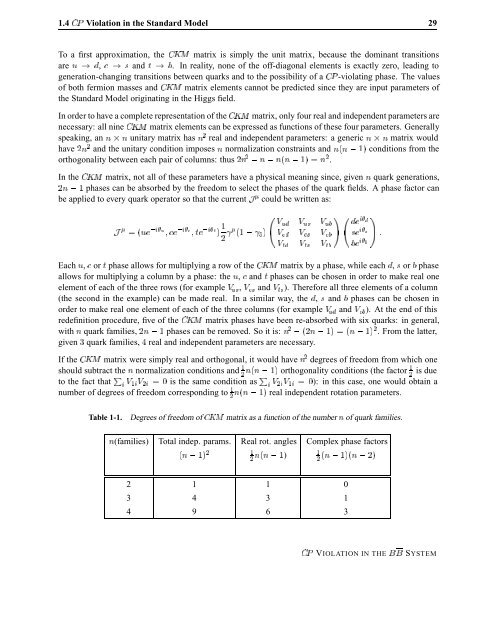Violation in Mixing
Violation in Mixing
Violation in Mixing
You also want an ePaper? Increase the reach of your titles
YUMPU automatically turns print PDFs into web optimized ePapers that Google loves.
1.4 �È <strong>Violation</strong> <strong>in</strong> the Standard Model 29<br />
To a first approximation, the �ÃÅ matrix is simply the unit matrix, because the dom<strong>in</strong>ant transitions<br />
are Ù � �, � × and Ø � �. In reality, none of the off-diagonal elements is exactly zero, lead<strong>in</strong>g to<br />
generation-chang<strong>in</strong>g transitions between quarks and to the possibility of a �È -violat<strong>in</strong>g phase. The values<br />
of both fermion masses and �ÃÅ matrix elements cannot be predicted s<strong>in</strong>ce they are <strong>in</strong>put parameters of<br />
the Standard Model orig<strong>in</strong>at<strong>in</strong>g <strong>in</strong> the Higgs field.<br />
In order to have a complete representation of the �ÃÅ matrix, only four real and <strong>in</strong>dependent parameters are<br />
necessary: all n<strong>in</strong>e �ÃÅ matrix elements can be expressed as functions of these four parameters. Generally<br />
speak<strong>in</strong>g, an Ò ¢ Ò unitary matrix has Ò real and <strong>in</strong>dependent parameters: a generic Ò ¢ Ò matrix would<br />
have Ò and the unitary condition imposes Ò normalization constra<strong>in</strong>ts and Ò Ò conditions from the<br />
orthogonality between each pair of columns: thus Ò Ò Ò Ò � Ò .<br />
In the �ÃÅ matrix, not all of these parameters have a physical mean<strong>in</strong>g s<strong>in</strong>ce, given Ò quark generations,<br />
Ò phases can be absorbed by the freedom to select the phases of the quark fields. A phase factor can<br />
be applied to every quark operator so that the current  � could be written as:<br />
 � � Ù� ��Ù � � �� �Ø� ��Ø �<br />
�<br />
ÎÙ� ÎÙ× ÎÙ�<br />
Î � Î × Î �<br />
ÎØ� ÎØ× ÎØ�<br />
� �����<br />
×� ��×<br />
Each Ù, or Ø phase allows for multiply<strong>in</strong>g a row of the �ÃÅ matrix by a phase, while each �, × or � phase<br />
allows for multiply<strong>in</strong>g a column by a phase: the Ù, and Ø phases can be chosen <strong>in</strong> order to make real one<br />
element of each of the three rows (for example ÎÙ×, Î × and ÎØ×). Therefore all three elements of a column<br />
(the second <strong>in</strong> the example) can be made real. In a similar way, the �, × and � phases can be chosen <strong>in</strong><br />
order to make real one element of each of the three columns (for example ÎÙ� and Î �). At the end of this<br />
redef<strong>in</strong>ition procedure, five of the �ÃÅ matrix phases have been re-absorbed with six quarks: <strong>in</strong> general,<br />
with Ò quark families, Ò phases can be removed. So it is: Ò Ò � Ò . From the latter,<br />
given quark families, � real and <strong>in</strong>dependent parameters are necessary.<br />
If the �ÃÅ matrix were simply real and orthogonal, it would have Ò degrees of freedom from which one<br />
should subtract the Ò normalization conditions and Ò Ò orthogonality conditions (the factor is due<br />
to the fact that È � Î �Î � � is the same condition as È � Î �Î � � ): <strong>in</strong> this case, one would obta<strong>in</strong> a<br />
number of degrees of freedom correspond<strong>in</strong>g to Ò Ò real <strong>in</strong>dependent rotation parameters.<br />
�� ���<br />
Table 1-1. Degrees of freedom of �ÃÅ matrix as a function of the number Ò of quark families.<br />
Ò(families) Total <strong>in</strong>dep. params. Real rot. angles Complex phase factors<br />
Ò Ò Ò ) Ò Ò<br />
2 1 1 0<br />
3 4 3 1<br />
4 9 6 3<br />
� �<br />
�È VIOLATION IN THE �� SYSTEM















